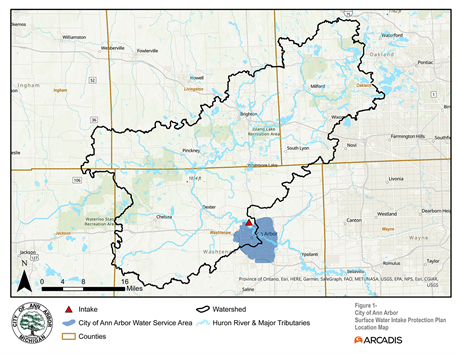Source water protection is key to both the health of Ann Arbor drinking water and the ecosystem of our community. As such, the City of Ann Arbor maintains a Wellhead Protection Plan (WHPP) and Surface Water Intake Protection Plan (SWIPP) within its Source Water Protection Plan.
Ann Arbor recently kicked off a project to update these plans. This effort is necessary to manage our drinking water resources now and into the future. The goal is to maintain a resilient and reliable source of drinking water to ensure the health of our community and ecosystems. This project will include updates to our Wellhead Protection Plan and Surface Water Intake Protection Plan under the direction and guidance of Michigan Department of Environment Great Lakes and Energy, or EGLE. Learn more about the EGLE Source Water Protection Program and watch this space for updates and opportunities to learn more as the work in Ann Arbor moves forward.
The City of Ann Arbor has a “One Water” approach, which brings all the departments managing water together with external stakeholders to provide quality water services and ensure the public health of the greater Ann Arbor community. The Source Water Master Plan project will strengthen our Ann Arbor Water Program and enhance the partnerships necessary to protect our water resources.
What is a Surface Water Intake Protection Plan?
Most (approximately 85 percent) of Ann Arbor’s drinking water is supplied by surface water from the Huron River. Ann Arbor’s existing Surface Water Intake Protection Plan evaluated the Huron River and its Source Water Protection Area to understand inputs that could impact water quality in the river, and then established water management and treatment strategies to ensure that drinking water in Ann Arbor is safe and reliable. The Source Water Protection Area (SWPA) is the river, its tributaries, and all the land that drains to river, starting from where the City draws its water. A key component of the plan is developing partnerships with other communities and stakeholders in the WHPA to collectively manage this important resource. The update currently underway will reevaluate and strengthen the existing water management strategies and partnerships.

What is a Wellhead Protection Plan?
In Ann Arbor, approximately 15 percent of our drinking water comes from wells that pump groundwater. Groundwater is the water beneath the surface stored in water-bearing gravel, sand, or clay deposits. The Wellhead Protection Plan maps the wellhead protection area, identifies potential sources of contamination within the area, and develops methods to manage the wellhead protection area and minimize potential threats to the public water supply. A wellhead protection area (WHPA) is the surface and subsurface area surrounding a water well that contributes groundwater to a public water supply system. The City of Ann Arbor’s Wellhead Protection Plan has been in place since 1996 and was last updated in 2017. We are updating our plan now to capture changes to conditions in the wellhead protection area and refresh management of our water resources as needed.
What can you do to protect our source water?
The Huron River is Ann Arbor's main source of drinking water. Did you know that the storm drains lead directly to the river, without treatment? Dumping waste into storm drains, ditches, or waterways is illegal and contaminates drinking water supplies, recreational areas, and wildlife habitat.
Everyday actions
Don't pour hazardous waste down the drain, on the ground, or into catch basins. Washtenaw County has a Household Toxics program that can help you dispose of these items.
Limit the use of pesticides or fertilizers, and always follow the label directions.
Dispose of medications properly. Residents should take advantage of Washtenaw County's pharmaceutical take-back collection program that accept prescription or over-the-counter drugs, as this program offers a safe and environmentally-conscious way to dispose of unwanted medicines.
If you live near a stream or the river, grow a vegetative buffer between your mowed lawn and the water's edge.
Help keep the area around storm drains clear of debris.
In the winter, reduce your use of salt on driveways and sidewalks.
Plant a tree. Trees help absorb and filter water of pollutants.
Clean up driveway spills as they happen and don't wash the material into the street.
